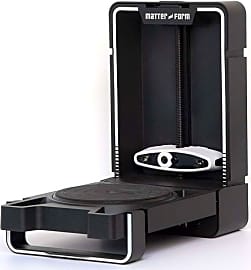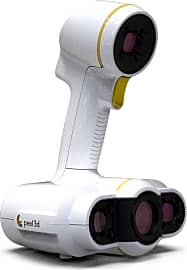The 5 Best 3D Scanners

This wiki has been updated 34 times since it was first published in June of 2016. Three-dimensional scanners can be used to analyze a real-world object or environment in order to collect data on its shape and appearance, and to expedite its recreation in a 3D printer or in virtual reality. We've included models on our list that come with integrated printers, as well as some designed to simply capture information, either to a dedicated piece of hardware or to another device. When users buy our independently chosen editorial choices, we may earn commissions to help fund the Wiki.
Editor's Notes
April 07, 2021:
We removed the Sol Desktop Laser, XYZPrinting Da Vinci, and a version of the EinScan due to major performance inconsistencies. We also moved the EinScan Pro 2x Plus down a couple spots because it's exorbitantly priced. Those are the only real changes we made this time around, as the remaining recommendations are as solid as the category allows.
Of course, those recommendations do come with a few caveats. These appliances are not for the faint of heart, so to speak, so if you're dead set on successfully 3D scanning things, know that it will take some tech know-how and significant attention to detail to get the results you're looking for.
February 03, 2020:
A couple of models from our previous selection saw upgrades that both decreased their scanning time and increased things like their accuracy and available scan area. The EinScan Pro 2x Plus, for example, gained one hundredth of a millimeter in precision, which may not seem like much at first, but in an animation environment or for detailed printing can make a big difference. We also found two new offerings, the Peel 2 Handheld Professional and the Sol Desktop Laser, each of which has an impressive area for its intended use, with the Peel's integrated LED light ultimately causing it to move up in the ranking. Only its price point held it back, as it has the same accuracy, or worse, than some of the less expensive competition.
In our special honors section we included a professional mode by Artec that's liable to only be of interest to serious businesses, VR designers, and animators, but we also removed the Occipital Structure from our main list and moved its Mark II iteration here, as it's something of a niche item that requires you to already own certain hardware to be effective.
Special Honors
Occipital Structure Senso A Kickstarter-funded device that's designed to attach to and integrate with any recent generation iPad, this offering comes with a software development kit that allows you to create your own 3D-powered apps and games. Its brackets aren't universal, however, so if you upgrade your tablet, you'll need new mounting hardware. structure.io
Artec Laser Ray While this is an undeniably expensive option, it's important to remember that it's designed for use in industries where it can generate a lot of vital data, like healthcare imaging. It's incredibly accurate, with a maximum distance of 110 meters, and it can be used on a tripod or handheld with a gimbal or other stabilizer to achieve the best results. artec3d.com
Using Technology To Reconstruct Real-World Objects
Time-of-flight devices can measure the distance of up to 100,000 points per second.
A 3D scanner analyzes a real-world object or environment in order to collect data on its overall shape and appearance. Like a camera, it uses a cone-like field of view with an ability to collect information about surfaces that aren't obscured. Although a camera collects data about the light reflecting off surfaces in its field of view, the 3D scanner specifically collects distance information about those surfaces. The device creates a point cloud, which is used to extrapolate and reconstruct the overall shape of an object within its field of view. Thinking of how a cloud in the sky consists of many small water droplets that form a larger shape, the 3D scanner is made up of many small data points that record surface details, texture, and color, ultimately creating a direct representation of the larger object being scanned.
This technology is classified into contact and non-contact types. Contact scanners physically probe an object that rests on a flat surface held in place by a fixture, an example of which might be a coordinate measuring machine. The disadvantage here is the potential alteration or damage that the probes may cause to the object.
By contrast, non-contact 3D scanners do not physically probe their source objects, and they are divided into active and passive varieties. Active scanners emit radiation and detect the reflection of that light passing through an object. Many non-contact active scanners use laser technology, including the time-of-flight and triangulation-based devices.
Using a laser range finder, time-of-flight scanners determine the distance to a surface by measuring the time it takes for a pulse of light to be reflected back to a receiver. Time-of-flight devices can measure the distance of up to 100,000 points per second. A triangulation-based scanner shines a laser on an object and uses a camera to look for the location of a laser dot. Depending on how far away an object's surface is struck, the laser dot appears at different places within the camera's field of view.
The structured light 3D scanner projects a series of light patterns onto an object. Interpreting the deformation of those patterns as a reference, it constructs a 3D image of its source object. It is also typically equipped with a camera to calculate the distance of every point in its field of view. Low-cost passive 3D scanners don't emit any light themselves, but they detect reflected ambient radiation to reconstruct 3D images.
The Abundance Of Possibilities
The benefits, applications, and intended industry of a 3D scanner will often inform which type of device is best to select. For example, if your profession involves the documentation of cultural artifacts for educational purposes, 3D scanning technology can be used to digitize a replica of those artifacts for study without the risk of damaging the originals. That said, if modeling is a big part of your job, consider a device that works as both a scanner and printer. Such a tool will allow you to rapidly construct your prototypes, giving you an edge when trying to get products to the market ahead of the competition.
Consider a solution with automatic object recognition, so your scans will always focus on the source object rather than on the background. Additionally, many 3D scanners include software that generates image mesh algorithms for superior accuracy.
If you do a lot of traveling, then look for a device small enough to accommodate easy transport. Some are even compatible with mobile devices.
A Brief History Of 3D Scanners
While 3D imaging is still a relatively new and emerging technology, the desire to recreate objects in this fashion dates as far back as ancient Egypt. Using precious linens and plaster materials, the Egyptians were quite skilled at creating replicas of actual mummies' heads.
Using precious linens and plaster materials, the Egyptians were quite skilled at creating replicas of actual mummies' heads.
The technology (as an industry tool) was introduced in the 1960s through the use of cameras, lights, and projector equipment to get the job done. The earliest digital 3D scanners appeared by the 1980s, using contact probes for physical contact with source objects to form data points that could be used to create a three-dimensional model. However, this early form of digital 3D scanning was extremely time-consuming.
By the late 1980s, the innovations of optical technology and lasers meant that precision 3D scanning could be accomplished faster than ever before. Today's 3D scanners not only leverage computers to create data points for object replication accuracy, but the technology is customizable and scalable to meet the needs of many different and growing industries.










